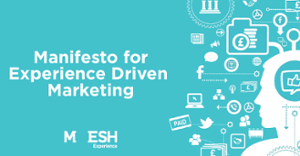Earlier in my career, I was the Planning Director of an Omnicom agency, Claydon Heeley, where I worked on brands like Mercedes-Benz.
Mercedes — now, there’s a brand that has it all: name recognition, a high-end reputation, and top-notch advertising to boot. The commercial at the time featured a man in shiny convertible in the desert, swerving this way and that while chased by ominous storm clouds to the tune of Mein Herz Brennt by Rammstein. Adventure and intrigue, looks and performance: perfect for a luxury vehicle.
I could get plenty of market research on how the ads were working. But it wasn’t enough; An advertisement is just a fraction of the larger story when it comes to brand experience. I take a very simple view of what a brand is. Brands exist in people’s heads as a group of perceptions. What is important is HOW these brands are created. Brand growth, therefore, is driven by all experiences people have with brands. Their trip to the dealership, for example, or noticing other drivers on the road — who may or may not be as easy-on-the-eyes as our advert’s actor. These are the everyday brand experiences that slip under the cracks, not to mention our consciousness, and more often than not go unmeasured.
It was this realization that led to me founding my company, MESH Experience. The principle was simple; If we could understand every single experience that someone had with Mercedes-Benz and its competitors — not just ATL (above-the-line) advertising — we could truly understand what was going on with our brand and make wiser marketing investments. We have developed an Experience Driven Marketing approach including evolved frameworks, models and metrics; Rather than look through a traditional marketing lens and measuring what we, as marketers, push out, we need to be permanently attuned to what real people are experiencing in their everyday lives.
Download our FREE Manifesto for Experience Driven Marketing and learn how this new framework can fuel your brand growth! 
When I set up MESH, I realized that those of us in marketing and advertising today have too much knowledge to keep spending money on banner ads like it’s the 90s. The adage “all publicity is good publicity” has long been a dated notion. We know that positive publicity is better, and that negative publicity can do more harm than good, impacting even beyond the moment to curb future positivity towards ads and potentially wasting marketing dollars.
In today’s data-driven world, we can prove it, too.
Our research shows that positive brand experiences have triple the impact of even neutral ones. Think about that for a second in terms of value proposition: if you know how to create a positive experience, you can save 66% of your budget or alternatively, get triple the impact with the same marketing dollars you might spend otherwise.
For brands, creating positive experiences is well-worth the time it takes to switch gears. But in order to do so, they need to understand what is positive, why, and how context, daily details, and emotion plays into the larger picture.
So, let’s start with the basics: What makes a positive brand experience?
The answer isn’t clear cut, because it depends on so many factors — factors that the brand, or their agency, must understand. There are three main ones to look for: proposition, placement, and context. A brand’s message (proposition) influences how the consumer feels, as does where it’s stationed (the placement): you’ll get different reactions on the train than you would near a supermarket, for example. As for context, look at it this way: a Monday morning experience will be totally different from the one you’ll have on Friday night.
In other words, our reactions to brands change with our environment, which are influenced by time and place.
Examples of positive experiences include a website that’s easy to navigate, an aptly timed radio ad for that treat you’re craving, or a well-positioned product endorsement. And they aren’t always what you would expect they’d be — you don’t need James Bond sporting your latest product to get a boost. As an example, we saw a larger increase in brand consideration for LG when the brand was experienced through a retailer’s commercial than through its own TV advertisement. Effectively, the retail mention was acting as an endorsement for the product. Knowing that an association between retailer and product is more positive than the product alone is an illuminating detail and cost effective exposure that LG could most certainly use to their advantage.
We already know that positivity is demonstrably powerful:for one of our clients, a % increase in share of positive experiences resulted in more than a twofold % increase in brand consideration the following month. This in turn should translate into a fantastic impact on sales. Once customers are converted to users, or even considered users, they tend to have even more positive experiences of that brand. It’s a virtuous cycle that is started and fueled by positivity.
Similarly, negative experiences need to be understood and avoided. According to research by the CMO Council, where an ad runs is just as important as what it says. 66% of those surveyed say their respect for brands decreases when they encounter ads near hateful, inappropriate, or distressing content.
For instance, our data has shown a clear surge of negative experiences relating to retail banking ads in the UK during the times that the news was full of branch closures. Of course commuters don’t want to think about the conveniences they’re losing as well as the impact on their local communities while they’re being sold banking products.
Negative brand experiences aren’t just damaging — they are contagious. Consider another piece of data: Americans tend to mention a good brand experience to an average of nine people, but will talk about a bad one to 16 people. If positive experiences yield triple the impact of neutral ones, on average, it seems that negative ones could accomplish nearly double that impact in damage.
Notice a trend, here? Positive and negative experiences alike have to be understood to get a holistic picture of your brand, and if content is king, context is most certainly queen.
“Create a positive experience, not a negative one” may seem like an obvious goal, but it’s easier said than done. You need the research to back it up and defend it, both beforehand and after the fact.
This means measuring how people feel about your brand on a total experience level, rather than studying select ad campaigns and calling it a day.
Totality matters if you want accurate market research. While the proportion varies by category, we’ve found that paid media can account for as little as 26% of people’s experience with brands. What about the other 74%? That’s a lot to just sweep under the rug.
Luckily, there are many ways to measure people’s interactions with, and feelings about, brands. We think it’s best done in real-time, because people are notoriously bad at reporting their emotions after the fact and tend to remember negative experiences more clearly than positive ones, so recall can easily skew data. For our purposes, online diaries have been extremely effective. When people record their real-world experiences and feelings as they unfold, it gives brands accurate insight into what they think and feel in the moment.
The key to unlocking your brand's potential is in leveraging available resources - data, research, insights - to uncover what is positive and why, to ultimately triple the impact of your marketing spend. It puts us in our customers’ shoes, no matter where they’re walking at that moment, and gives us control over the message we’re sending.
Seen in this light, that Mercedes-Benz stuntman out-driving the storm is an apt analogy. In order to make smarter, more impactful decisions, an industry needs to stay ahead of the negatives, fuel positivity at every touchpoint, and stay agile — especially when the clouds roll in.
Contributor:
Fiona Blades, President and Chief Experience Officer, MESH Experience

